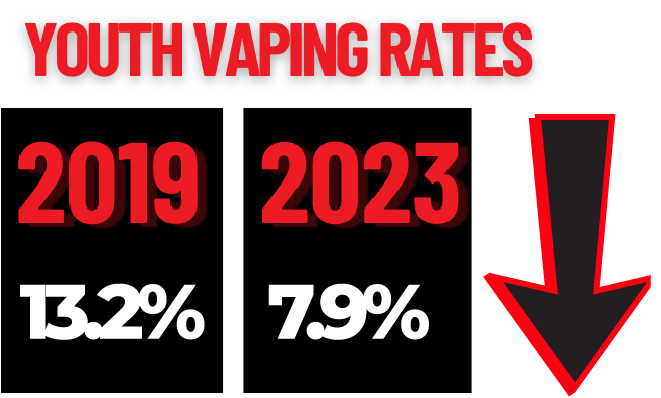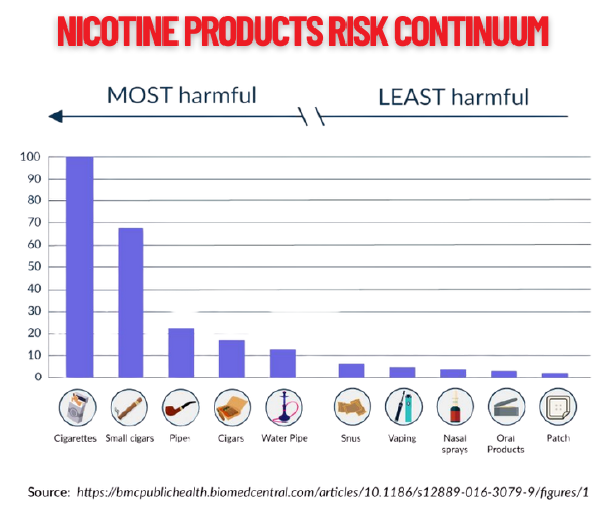
Strong & Free: Protecting the Right to Safer Nicotine Choices
Thanks for showing up!
You’ve just landed on Canada’s largest consumer movement advocating for the rights of adult Canadians to access safer nicotine products—including vaping and nicotine pouches.
At Rights 4 Vapers (R4V), we believe in science, harm reduction, and the freedom to choose less-harmful alternatives to smoking.
Want to stay up to date with our going ons? Join our email list
What We Stand For
- Freedom of Choice: Adults deserve access to safer nicotine options without excessive regulation or punitive taxation.
- Science-Based Policy: Public Health England, Health Canada, and the Cochrane Review all recognize that vaping is less harmful than smoking.
- Community Power: R4V has mobilized hundreds of thousands of Canadians—sending over 100,000 letters to MPs in just the past year, pushing back against flavour bans and unfair taxes.
- Transparency & Education: We’re committed to fighting misinformation with facts and supporting responsible, adult access.
What You Can Do
- Stay informed on the latest science, legislation, and advocacy efforts
- Help protect the 1.9 million adult Canadians who vape instead of smoke
- Make your voice heard in the face of growing restrictions



We know that things have to change. We need strong leadership from our federal government. Here is our plan:
The Safer Nicotine Act
The most effective action the federal government can take is to establish a new regulatory framework for safer nicotine products—including vaping—through the Safer Nicotine Act.
Currently, vaping is regulated under the Tobacco and Vaping Products Act, which creates a major issue: it reinforces the false belief that vaping and smoking are the same. Vaping is not smoking, and it should not be regulated or taxed in the same way as cigarettes.
Furthermore, it should never be easier or more affordable to buy cigarettes in Canada than it is to access smoking cessation tools or vapour products. Unfortunately, that’s the situation we face today.
Safer nicotine products—such as vapour products and nicotine replacement therapies—should be sold in the same locations as cigarettes and regulated as consumer products.
The federal government, in collaboration with Canadian stakeholders, should develop a National Strategy for Safer Nicotine Products. This strategy should be based on the latest science and aim to create consistent regulations across the country. The ultimate goal: support innovation while ensuring adult access to safer alternatives.
Want to learn more about our plan for the Safer Nicotine Act? Register here
Sign up for our newsletter to get important updates, campaign actions, and breaking news straight to your inbox.
Together, we’re keeping Canada strong, smoke-free, and free to choose.
Cochrane Review on E-Cigarettes: What You Need to Know
What Is It?
Cochrane is an independent global network that reviews health research to guide medical decisions. They published their first review on e-cigarettes for quitting smoking in 2014. At the time, evidence was limited.
Latest Findings (2023):The most recent review includes 88 studies with over 27,000 participants, making it the most comprehensive to date.
Key takeaways:
- Nicotine e-cigarettes help more people quit smoking than traditional nicotine patches or gum.
- They’re also more effective than no help or behavioral support alone.
- No serious health risks were found in the short to medium term (up to 2 years); common side effects like throat irritation were mild.
- Long-term safety is still being studied.
Why It’s Trustworthy:
Cochrane maintains strict neutrality:
- No industry funding (tobacco, pharma, or vaping companies)
- Transparent methods and peer-reviewed protocols
- Regular updates based on new evidence
Cochrane’s review shows strong evidence that nicotine e-cigarettes can be a more effective tool to quit smoking than other methods, with no serious short-term health concerns—but long-term effects still need more research.
Hands Off Our Flavours: The Fight to Protect Safer Nicotine Options in Canada
In March 2024, then-Minister of Health Mark Holland, a former executive at Heart and Stroke, announced his intent to ban all flavours in non-pharmaceutical safer nicotine products—including vapes and nicotine pouches. This move sparked immediate and widespread backlash from Canadians who rely on these products as less harmful alternatives to smoking.
Over the next six months, more than 100,000 letters were sent to Members of Parliament and Ministers across Canada. The message was loud and clear: “Hands off our flavours!”
The concern wasn’t just about flavours—it was about process. Through the federal budget bill, the government granted the Minister of Health sweeping new powers to unilaterally remove a broad range of health products from the market, without public consultation. This allowed Minister Holland to:
- Remove nicotine pouches from convenience store shelves
- Restrict flavoured products to pharmacies only
- Set a precedent for future ministers to do the same, unchecked for any approved drug in Canada.
Many saw this as a personal agenda rooted in Holland’s previous role at Heart and Stroke, rather than a policy grounded in harm reduction or evidence. But Canadians pushed back.
As of today, flavoured nicotine products remain legal at the federal level. However, several provinces have imposed severe restrictions, unintentionally fuelling a growing black market as consumers seek out the products they previously accessed legally.
Youth Vaping Rates Are Declining in Canada: 2023 Data Confirms a Positive Shift
Despite alarmist headlines, the reality is that youth vaping in Canada is on the decline—a trend that mirrors recent progress seen in the United States as well.
According to Statistics Canada’s 2023 data, the percentage of youth aged 15 to 19 who reported using a vaping product in the past 30 days has dropped significantly over the last few years.
- In 2019, 13.2% of youth reported vaping in the past 30 days.
- By 2023, that number had fallen to 7.9%.
This represents a 40% decline in youth vaping over four years.
This downward trend challenges the often-repeated narrative that youth vaping is “out of control.” Instead, it suggests that public education, access restrictions, and regulatory measures are having their intended effect: reducing regular use among teens while preserving access for adult smokers seeking harm reduction.

Canada’s Vaping Industry Faces Rising Tax Pressure
The federal excise Tax was introduced October 2022 In the first 18 months Canada collected $617 million in excise tax on vaping products. Provinces that opt into the system must match the federal rate, doubling the tax burden.
In Ontario, vaping products are taxed at 182% of wholesale value—higher than cigarettes at 168%. This harsh taxation stems from anti-vaping policy recommendations aimed at curbing youth use, despite vaping’s role in harm reduction.
The 2024 federal budget added another 12% tax, or 24% in participating provinces, resulting in a 124% total increase in just one year. The excise rate now stands at:
- $2.24 per mL for the first 10 mL
- $2.24 per additional 10 mL
The industry—made up of 2,400+ small businesses—supports over 10,000 jobs and 1.9 million adult vapers. The tax burden is unsustainable:
- A $6,319.65 order now incurs up to $23,822.40 in excise tax (before HST).
- 200 vape stores closed in Ontario between Oct 2024 and Jan 2025.
Higher prices push adults toward illicit products or back to smoking, undermining harm-reduction goals. Yet, youth vaping is declining, proving regulation works without excessive taxation.
Vaping is a $2 billion industry with public health value. A more balanced tax policy is needed—one that supports smokers seeking alternatives without punishing small businesses or helping the black market thrive.

What Health Canada Says About Vaping
While Health Canada maintains a cautious approach to vaping—especially around youth access and long-term health effects—it has consistently recognized the role vaping can play in helping adult smokers quit combustible tobacco.
Here are some key points Health Canada has made that highlight the potential benefits of vaping for Canadians:
- Vaping Is Less Harmful Than Smoking
Health Canada has clearly stated:
“If you are a smoker, switching completely to vaping is less harmful than continuing to smoke.”
This reflects the scientific consensus that combustible tobacco products—which involve burning and inhaling thousands of chemicals—pose far greater risks than vaporized nicotine, which eliminates combustion.
- A Tool to Help Smokers Quit
Health Canada acknowledges that vaping products can be effective for smoking cessation when used correctly:
“There is evidence that using vaping products is less harmful than smoking cigarettes and that they can help people quit smoking.”
